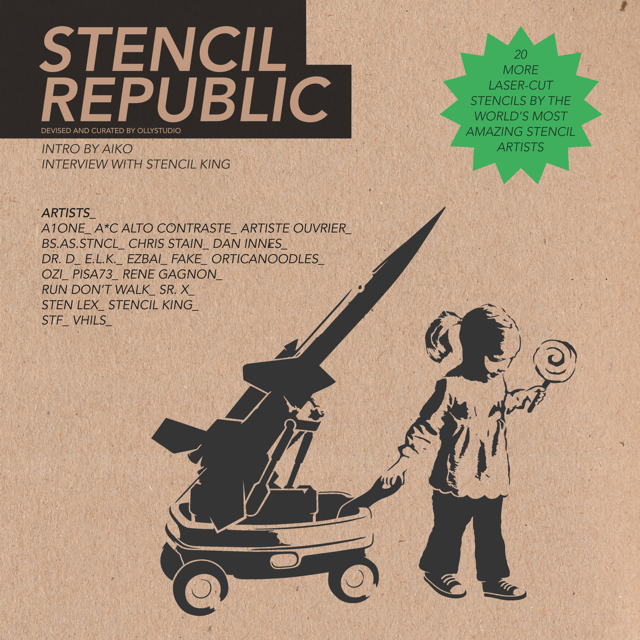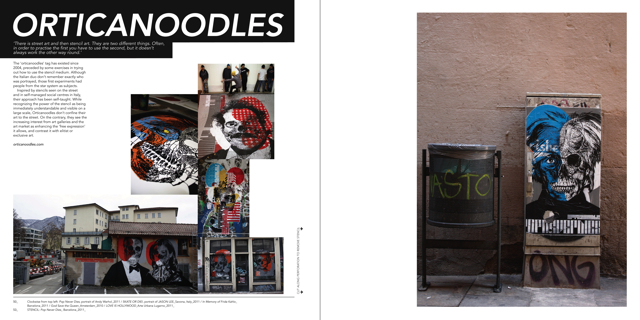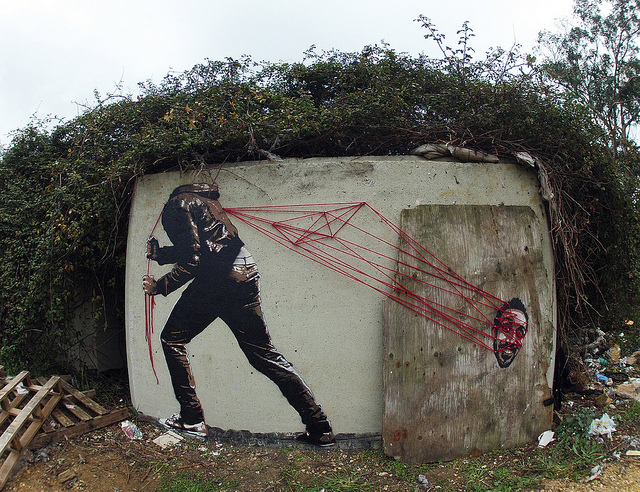
Ollystudio’s book Stencil Republic does not attempt to remind readers of how awesome Blek and Banksy are, or of the importance of John Fekner. Rather, Stencil Republic highlights some of the current favorite stencil street artists (such as A10ne, Run Don’t Walk, Sten & Lex, A*C Alto Contraste, Sr. X, Chris Stain, and more) as it attempts to embrace and delineate the scene as it stands today. As Aiko explains in her intro, stencils have become such a widely embraced tool of expression that many stencil-artists are a flash in the pan, with few maintaining a lasting presence in the scene. Rather than heralding the history-makers, Stencil Republic focuses on the top stencil-cutters of the moment, resulting in a refreshing mixture of strong work by well-known and not-so-well-known stencil artists.



One of the more outstanding and controversial aspects of this book is that, with each introduction to an artist, readers are presented with a laser cut stencil of the artist’s design. While the quality of these stencils are impressive, and in my opinion, what sets this book above others of its kind, I can imagine some contention arising in response to giving the public twenty replica stencils by artists who are potentially still putting up these same works. In a way this controversy is reminiscent of Tox’s court case, where his key defense was the fact that anyone could replicate his tag. By agreeing to participate in Ollystudio’s book, have the artists in Stencil Republic signed on to a sort of vandal-insurance should they ever get caught putting up work illegally?
As I showed some friends this book, I inquired as to whether they, as both the audience of the work and as potential participants in it’s distribution, felt that the artists’ “credit” was being challenged, or thought that “credit” even mattered at all. It seemed that the grassroots understanding of street art was that its intent is to beautify an environment or to spread an idea but not necessarily to proliferate an identity, in contrast to graffiti. In this sense, this book should help to spread street art. But again, this question of identity vs. credit came up, seeing as this was something that each artist who participated in this book needed to consider before agreeing to relinquish the right to recreate and distribute their work to the public. I’m curious if “credit” mattered to them; whether they thought that the public would still know the design was theirs, and whether the person who physically puts a piece up is actually significant to the piece itself. Take the “OBEY” campaign for example: though it started as the individual efforts of Shepard Fairey, the ubiquity of the Andre the Giant icon grew to outstanding proportions when the task of getting the image up was taken over by any willing participant.
I am not bringing up these questions as a criticism of the quality of Ollystudio’s product. Actually, these dilemmas would not exist if these stencils were not so exquisitely cut. I would recommend purchasing this book for a few reasons: 1. It’s a good conversation piece on appropriation of art; 2. You really should get to know these current artists – they’re talented; 3. It is a splendid reminder that vandalizing is fun (but don’t do that -blah blah- legal disclaimer).
Photos courtesy of Laurence King Publishing and by Caroline Caldwell



